
Here you can study for the exam. Look up keywords and learn definitions about all kind of subjects.
More subjects
The Plummer Terrier is a working terrier. It was originally bred by Brian Plummer to hunt vermin, especially rats. The breed, while unrecognized by any kennel club, is known for its rugged determination and hardiness. The Plummer Terrier is a striking dog to look at, its fiery red coat should conform to two distinct patterns collared (a white band around the neck) and caped (only showing white on the throat). They should be heavily coloured and preferably be no more than 14” at the shoulder. Terriers that do not possess collared or caped markings are labelled shattered, they are perfectly fine as workers, companions but are not classed as good examples of the breed. The same can be said for tricolours, dogs which carry black in their colouring. The ears fold over like most terriers, and the nose and eye are typically black, and the jaw has a good scissors bite. (Source: Wikipedia.org, CC BY-SA)
Podenco Canario (In English: Canary Island Podenco, Canary Island Hound, or Canarian Warren Hound) is a breed of dog from the Canary Islands. The Podenco Canario is still used today, primarily in packs, most often for the sport hunting of rabbits. The word 'podenco' in Spain refers to a certain type of dog, typically rabbit hunters with the same body shape. 'Canario' is a reference to its region of origin, the Canary Islands. The Spanish Kennel Club, Real Sociedad Canina de España, recognises the following similar dog breeds that use the identifier 'podenco' in their names: Podenco Andaluz, Podenco Ibicenco, and Podenco Valenciano. (Source: Wikipedia.org, CC BY-SA)
The Pointer, sometimes called the English Pointer, is a medium-sized breed of pointing dog developed in England. Pointers are used to find game for hunters, and are considered by gundog enthusiasts to be one of the finest breeds of its type; however, unlike most other hunting breeds, its purpose is to point, not retrieve game. The Pointer is a medium-sized, athletic breed that is built for both endurance and speed. They typically stand between 53 and 71 centimetres (21 and 28 in) with bitches being shorter than dogs. The breed standard of The Kennel Club states that dogs should stand 64 to 69 centimetres (25 to 27 in) and bitches 61 to 66 centimetres (24 to 26 in). The breed usually weighs between 20 and 34 kilograms (45 and 75 lb), with dogs weighing 25 to 34 kilograms (55 to 75 lb) and bitches 20 to 29 kilograms (45 to 65 lb). The Pointer has a very distinctive head with a slightly dished face and elevated nose, a raised brow, and wide nostrils, their ears are hanging and lie close to the face, are high set, medium-sized, and slightly pointed. (Source: Wikipedia.org, CC BY-SA)
The Polish Greyhound (Polish: chart polski, pronounced [xart ˈpɔlskʲi]) is a Polish sighthound breed. It is known as the Polish Greyhound, although it is not a direct relative of the Greyhound dog. Polish Greyhounds have short, smooth fur that comes in many colors. The coat is somewhat heavier than a Greyhound. They have an undercoat that gets thicker in the winter. Polish Greyhounds have a long brush on the tail and have culottes at the rear of the thighs. The average Polish Greyhound weighs about 60 - 90 pounds, and ranges from 27 to 32 inches tall. The Chart Polski has a smooth double coat, regardless of season, which is harsh to the touch while offering excellent insulation. The breed is a persistent hunter, with a long muscular neck, unlike the Greyhound, and the head is carried high. Large almond eyes are set in a slant, and the points of the hip bones are wide apart. The hind legs move closer together when the dog is moving at a short trot: this is called 'lacing'. (Source: Wikipedia.org, CC BY-SA)
The Polish Hound, commonly known as Ogar Polski, is a breed of hunting dog indigenous to Poland. The Polish Hound has a keen sense of smell. This heightened sense combined with the endurance needed to hunt in harsh environments led to its use in hunting, while its stature made it popular with Polish nobility. The Polish Hound has an average life span of 13 to 14 years.[better source needed] A medium-sized breed, Ogar Polski is often described as strong and sleek, with a powerful bone structure. The coloration of these animals is often a combination of a brown underside and black on top running from the neck to the tail. The breed has thick double coat, which ensures water resistance on outer and underlying skin layers. The Polish Hound's voice is often described as resonant and pure which makes it an ideal hunting dog. (Source: Wikipedia.org, CC BY-SA)
 © Wikimedia.org/Anna Walentynowicz, CC BY
© Wikimedia.org/Anna Walentynowicz, CC BY
The Polish Lowland Sheepdog (Polish: Polski Owczarek Nizinny, also PON), is a medium-sized, shaggy-coated, sheep dog breed native to Poland. The PON is a muscular, thick-coated dog. The double coat can be of any color or pattern; white, gray, and brown are most common, with black, gray, or brown markings. It is common for colors to fade as the dogs reach adulthood. The undercoat is soft and dense, while the topcoat is rough and either straight or wavy, but not curly. The hair around the head makes the head appear to be larger than it actually is, and typically covers the eyes. (Source: Wikipedia.org, CC BY-SA)
The Pomeranian (often known as a Pom) is a breed of dog of the Spitz type that is named for the Pomerania region in north-west Poland and north-east Germany in Central Europe. Classed as a toy dog breed because of its small size, the Pomeranian is descended from larger Spitz-type dogs, specifically the German Spitz. It has been determined by the Fédération Cynologique Internationale to be part of the German Spitz breed; and in many countries, they are known as the Zwergspitz ('Dwarf Spitz'). Pomeranians are small dogs weighing 1.36–3.17 kilograms (3.0–7.0 lb) and standing 8–14 inches (20–36 cm) high at the withers. They are compact but sturdy dogs with an abundant textured coat with a highly plumed tail set high and flat. The top coat forms a ruff of fur on the neck, which Poms are well known for, and they also have a fringe of feathery hair on the hindquarters. (Source: Wikipedia.org, CC BY-SA)
The Pont-Audemer Spaniel or Epagneul Pont-Audemer is a rare breed of French gundog. It originated in the nineteenth century from different breeds of water spaniels, and took more of a setter role in hunting than that of a traditional spaniel. Following the Second World War, the breed's numbers dropped so low that the breed club decided to allow cross breeding with other breeds because of fears of the existing stock becoming overly inbred. In 1980, the breed club was merged with that of the Picardy Spaniel. The Pont-Audemer Spaniel is a medium-sized dog, weighing 44 to 60 pounds (20–27 kg), and standing around 50–58 centimetres (20–23 in) at the withers. It is different from most sporting dog breeds in the USA and UK in its length, and the pointed quality of the muzzle. The Pont-Audemer Spaniel's coat is curly or, at the very least, quite wavy, but smooth around the face (Source: Wikipedia.org, CC BY-SA)
The Poodle, called the Pudel in German and the Caniche in French, is a breed of water dog. The breed is divided into four varieties based on size, the Standard Poodle, Medium Poodle, Miniature Poodle and Toy Poodle, although the Medium Poodle variety is not universally recognised. They have a distinctive thick, curly coat, and come in many colors, with only solid ones recognized by breed registries. While a reasonably healthy breed, they are prone to sebaceous adenitis and Addison's disease among other genetic disorders. (Source: Wikipedia.org, CC BY-SA)
The Porcelaine [pɔʁsəlɛn] is a breed of dog originating from France. In 1844, this scent hound was originally called “Briquets Francs Comtois” and named after a French region bordering Switzerland. The Porcelaine gets its name from its shiny coat, said to make it resemble a porcelain statuette. The fur is white, sometimes with orange spots, often on the ears. The skin should be white with black mottling that is visible through the white coat. The fur is incredibly short and very fine. The nose of a Porcelaine dog is black with very wide nostrils. It also has black eyes and long ears that droop down. The neck is long and the tail starts thick and narrows to a point at the end. (Source: Wikipedia.org, CC BY-SA)
The Portuguese Podengo, also known as the Podengo Português or Portuguese Warren Hound, is a hound (sight and scent) breed from Portugal. As a breed, the Podengo is divided into three size categories that are not interbred: small (Pequeno), medium (Médio) and large (Grande). Their coats are either short and 'smooth', or longer and 'wired'. The smooth coated variety is traditional, whereas the wire coated variety is an outcome of the assimilation of various other breeds during the 20th century. In general, the breed is healthy; the Pequeno (small) variety has an average lifespan of approximately 15–17 years. All Podengo types are hardy, intelligent and lively dogs, excelling at agility and making fine companions. Loyal and fearless, Podengos are also good house guards and are amenable to training by dog experienced people and those that enjoy primitive (unrefined, 'less domesticated') dog behavior. (Source: Wikipedia.org, CC BY-SA)
A Portuguese Pointer, (Portuguese: Perdigueiro Português) is a breed of dog developed as a gun dog. It is one of several pointing breeds and is mainly used in red-legged partridge hunting. The Portuguese Pointer is a dog of medium proportions. The height at the withers is 48–56 cm (19–22 in). The weight is 18–27 kg (40–60 lb) for males, and 16–25 kg (35–55 lb) for females. The coat is short and coarse on most of the dog, being the texture of velvet on the ears and face. The Portuguese Pointer does not have an undercoat. The Portuguese Pointer has an average life expectancy of 14 years. They are considered a hardy breed with no known health issues specific to them. However, hip dysplasia, patellar lunation, cancer, and autoimmune diseases are potential health concerns for dogs of this size. (Source: Wikipedia.org, CC BY-SA)
The Portuguese Sheepdog (Portuguese: cão da Serra de Aires, literally 'dog of Serra de Aires') is a medium-sized breed of dog of the herding dog type, and is one of the indigenous regional dogs of Portugal. Portuguese Sheepdog is a medium-sized dog, standing 45 to 55 cm (17½ to 21½ ins) at the withers for males (females slightly smaller) and 17 to 27 kg (37 to 60 lbs) in weight. The dog's body is long and has a long coat without an undercoat, of medium thickness and described as having a 'goat like' texture.[clarification needed] The lack of an undercoat makes the dog less resistant to extreme weather as a working dog.[citation needed] Typical coat colours include yellow, chestnut, grey, fawn, wolf grey (fulva e a lobeira), and black, with tan marks. White hairs may be mixed in with the coat, but there should be no large white patches. (Source: Wikipedia.org, CC BY-SA)
The Portuguese Water Dog originated from the Algarve region of Portugal. From there the breed expanded to all around Portugal's coast, where they were taught to herd fish into fishermen's nets, retrieve lost tackle or broken nets, and act as couriers from ship to ship, or ship to shore. Portuguese Water Dogs rode in fishing trawlers as they worked their way from the Atlantic waters of Portugal to the waters off the coast of Iceland fishing for cod. Portuguese and Spanish water dogs are clearly related and probably have a common ancestor. The closest relatives of the PWD and Spanish Water dog are widely thought to be the Standard Poodle. Like Poodles and several other water dog breeds, PWDs are intelligent, can have curly coats, have webbed toes for swimming, and do not shed. However, Portuguese Water Dogs are more robustly built, with stout legs, and can have a wavy coat instead of tightly curled. (Source: Wikipedia.org, CC BY-SA)
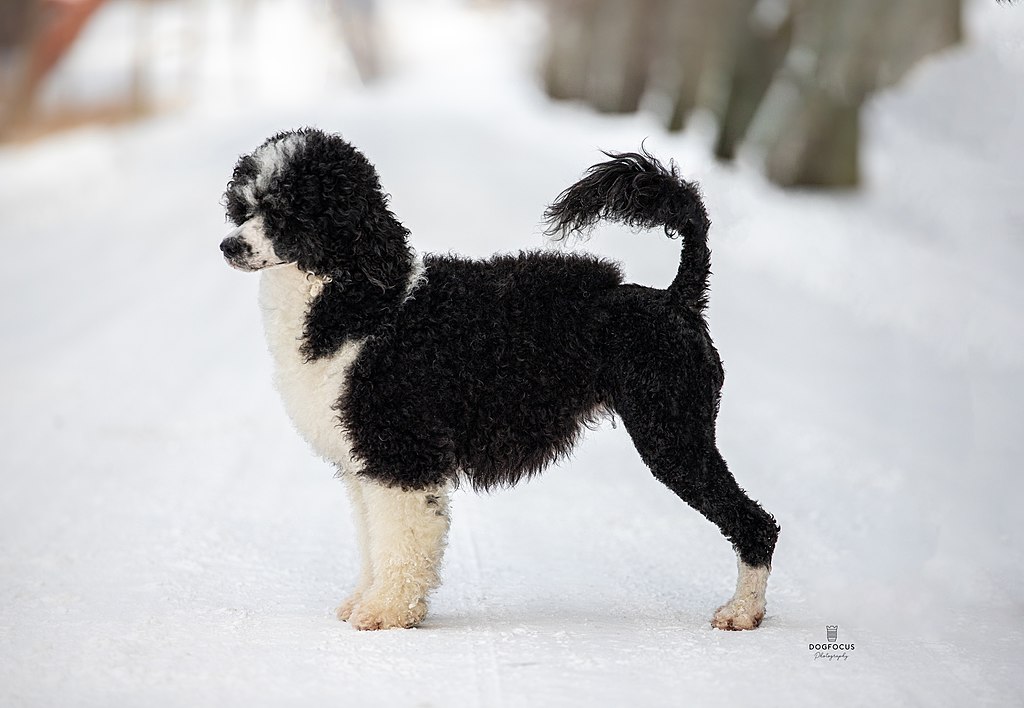 © Wikimedia.org/TempusAdMiraculum, CC BY-SA
© Wikimedia.org/TempusAdMiraculum, CC BY-SA
The Posavac Hound (FCI No. 154) (Croatian: posavski gonič) is a breed of dog, originating as a hunting dog of the scenthound type. Croatia is the home country for the breed. The name translates into English as the Scenthound From The Sava Valley, but is usually translated as the Posavac Hound. The Posavac Hound is a solidly built dog with a somewhat long body, close-fitting drop ears, a long tail, and a gentle expression. The breed has an ideal height around 50 cm (20 ins) at the withers. The short, flat coat is slightly longer on the belly and backs of legs (feathering). Coat colour is a reddish wheaten, marked with white. (Source: Wikipedia.org, CC BY-SA)
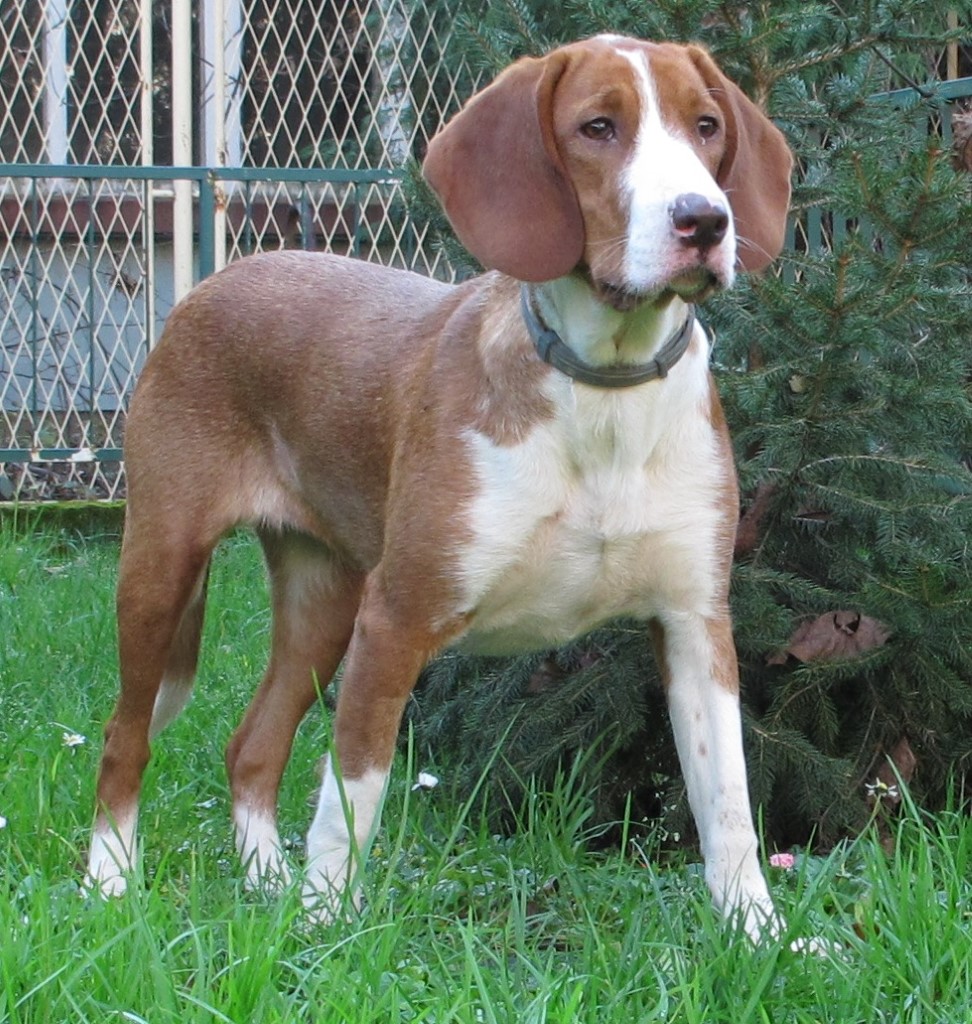 © Wikimedia.org/Strojovodjazg, CC BY-SA
© Wikimedia.org/Strojovodjazg, CC BY-SA
The Pražský Krysařík (Prague Ratter) is a small breed of dog from the Czech Republic that is rarely seen outside its country of origin. It is the smallest breed in the world by breed standard, because of the maximum height of the dogs, unlike Chihuahuas who are measured by weight. Also known as the Pražský Krysařík, and often confused with the Chihuahua and the Miniature Pinscher, the Prague Ratter is a small toy dog. Ideal height is 20 cm to 23 cm, being 2 cm shorter in maximum height than the minimum height of the Miniature Pinscher. Adult weight is mostly between 1.5 kg to 3.5 kg. Generally the best weight is 2.6 kg. (Source: Wikipedia.org, CC BY-SA)
 © Wikimedia.org/Mikko Virtaperko, CC BY-SA
© Wikimedia.org/Mikko Virtaperko, CC BY-SA
The Presa Canario is a Spanish breed of large dog of mastiff or catch dog type. It originates in the autonomous region of the Canary Islands, and is found mostly in the islands of Gran Canaria and Tenerife. It was formerly known as the Dogo Canario. It was traditionally used as a guard dog, as a herding dog for both sheep and cattle, and for dog-fighting, which was legal in Spain until 1936 and may have continued clandestinely thereafter. The Presa Canario is a large dog with a heavy muscular body. Dogs stand 60–66 cm at the withers and weigh some 50–65 kg; bitches stand about 56–62 cm and weigh approximately 10 kg less. The head is broad, massive, square, and powerful brachycephalic shape. Proper head and good expression are part of the breed standard, and are manifest in the best breed specimens. The ears are normally cropped, both to create a more formidable expression and to prevent damage while working with cattle. (Source: Wikipedia.org, CC BY-SA)
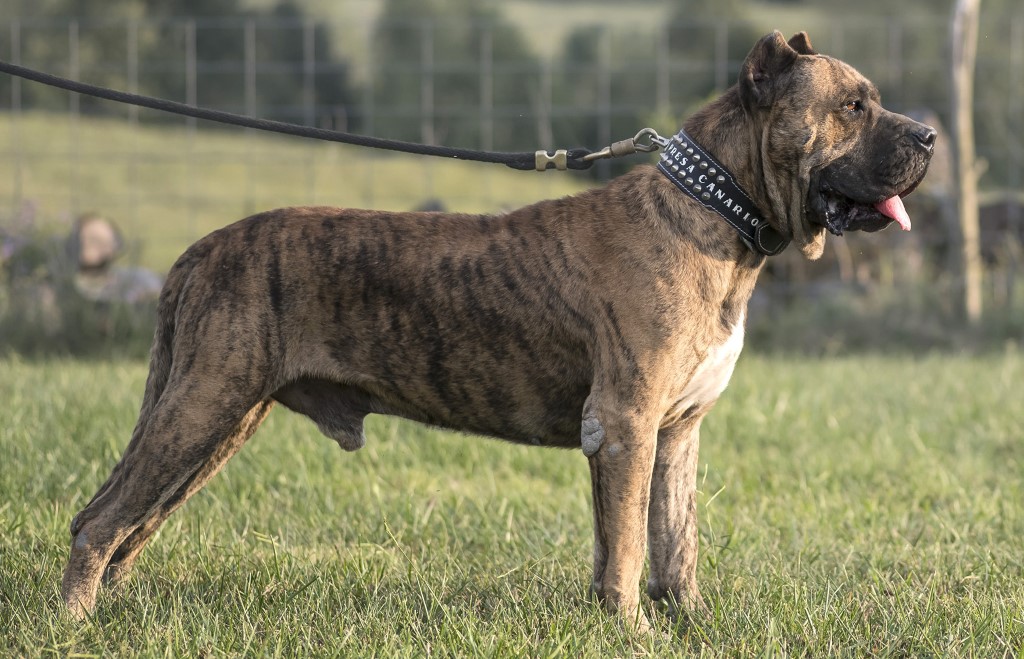 © Wikimedia.org/Smok Bazyli, CC BY-SA
© Wikimedia.org/Smok Bazyli, CC BY-SA
The Kurdish Mastiff, Assyrian Shepherd, or Pishdar dog (Kurdish: سەگی پشدەری) is a dog landrace native to the mountainous Kurdistan Region in Iraq. This dog is often used as a livestock guardian against predators and number around a few thousand heads. They have been compared to the Kangal Dog and the Akbash. The weight of the adult dogs increases with age and can reach 80 kg. The average is at 73.50 kg reaching from 67 kg in Sangasar to 80 kg in Qira Diza. The average body length is about 75 cm with the back length of aged dogs reaching over 88 cm. (Source: Wikipedia.org, CC BY-SA)
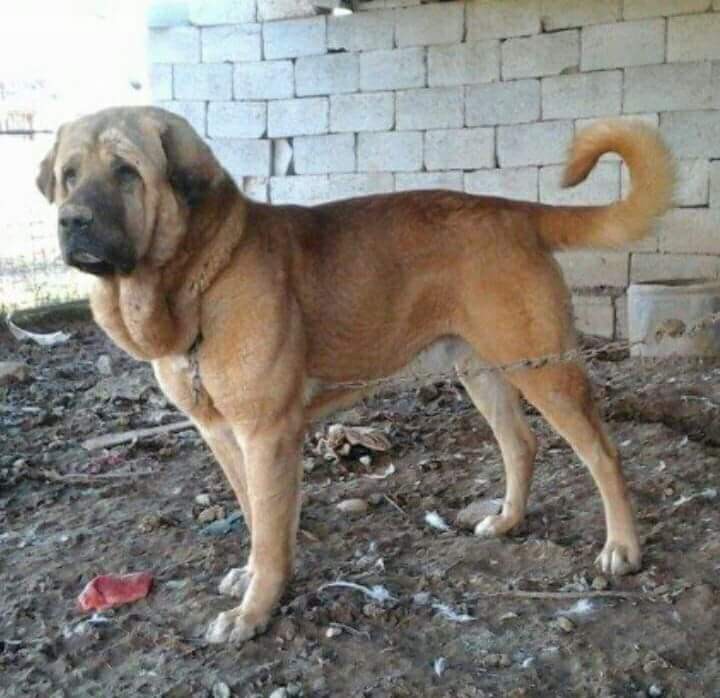 © Wikimedia.org/Mohamad137026, CC BY-SA
© Wikimedia.org/Mohamad137026, CC BY-SA
The Pudelpointer is a versatile hunting dog breed from Germany. It is a pointing breed that came from a cross between the German hunting poodle (pudel) and the English Pointer. The breed weighs between 44 and 66 lb (20 and 30 kg), stands 21 to 26 in (53 to 66 cm) at the shoulder, and comes in liver, chestnut, and occasionally black coats. The ideal coat is harsh, wiry, and dense. The dogs shed very little. (Source: Wikipedia.org, CC BY-SA)
The Pug is a breed of dog originally from China, with physically distinctive features of a wrinkly, short-muzzled face and curled tail. The breed has a fine, glossy coat that comes in a variety of colors, most often light brown (fawn) or black, and a compact, square body with well developed and thick muscles all over the body. Pugs are known for being sociable and gentle companion dogs. The American Kennel Club describes the breed's personality as 'even-tempered and charming'. Pugs remain popular into the twenty-first century, with some famous celebrity owners. (Source: Wikipedia.org, CC BY-SA)
The Puli is a small-medium breed of Hungarian herding and livestock guarding dog known for its long, corded coat. The tight curls of the coat appear similar to dreadlocks. A similar-looking, but much larger breed – also Hungarian – is the Komondor. Plural form of Puli is Pulik in Hungarian. The Puli is a solid-colored dog that is usually black. Other less common coat colors are white, gray, or cream (off-white or fakó in Hungarian). A variety of the cream-coated dogs have black masks. The white Pulis are not albino, nor do they have blue eyes. They commonly have dark pigment, black pads, black noses and black pigment inside the mouth. The white gene is recessive to the pure black gene. The breed standard for females is about 16.5 inches (42 cm) at the withers and 17 inches for males. Females weigh 23-25 pounds and males slightly more. The coat of some Puli dogs can be different with either thinner or thicker cords which can be flat or round depending on the texture of the coat and the balance of undercoat to outer coat. (Source: Wikipedia.org, CC BY-SA)
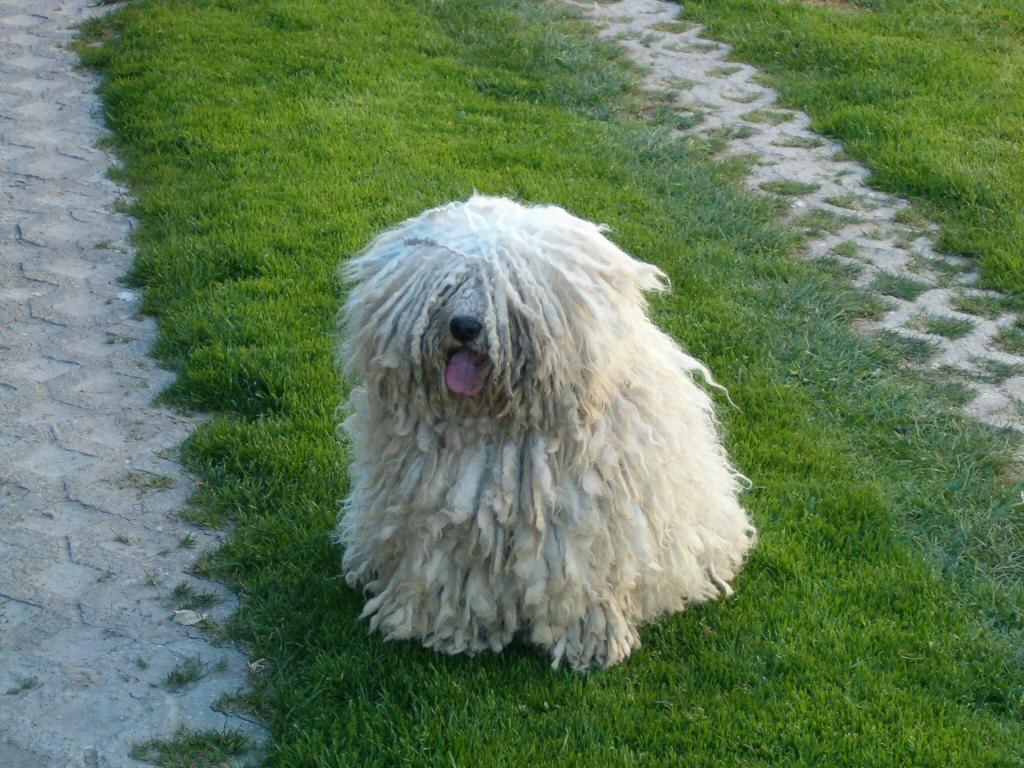 © Wikimedia.org/András Somogyi, CC BY-SA
© Wikimedia.org/András Somogyi, CC BY-SA
The Pumi (in Hungarian, the plural form is pumik) is a medium-small breed of sheep dog from Hungary. They are versatile stock dogs equally adept at gathering, driving and keeping stock under control. They have a long head with semi-erect ears, a whimsical expression, and a tail that forms a circle over the back. The coat (black, white, grey, or fawn) is a combination of wavy and curly hair forming curls all over the body. Pumis can be in varying shades of grey, white, or fawn (known as 'fako' in Hungary). Grey Pumis are the most common, born black, and ranging from almost black to light grey in adulthood. Puppies usually start greying at six to eight weeks old and the shade progressively lightens. The final shade is predicted by the colour of the parents. Other accepted colours are black, white, and cream to red with a darker mask, known as fawn with mask. (Source: Wikipedia.org, CC BY-SA)
The Pungsan, Phungsan, Korean Phungsan, or Poongsan (Chosongul: 풍산개; Hanja: 豐山개) is a breed of hunting dog from Korea, named for originating in Kim Hyong Gwon County, formerly Phungsan county. They were bred in the Kaema highlands of what is now North Korea, and were traditionally used as hunting dogs. The dog is a rare breed, and is sometimes smuggled over the North Korea–China border. The dog was made a national monument of North Korea in April 1956, and the national dog of the DPRK in 2014. (Source: Wikipedia.org, CC BY-SA)
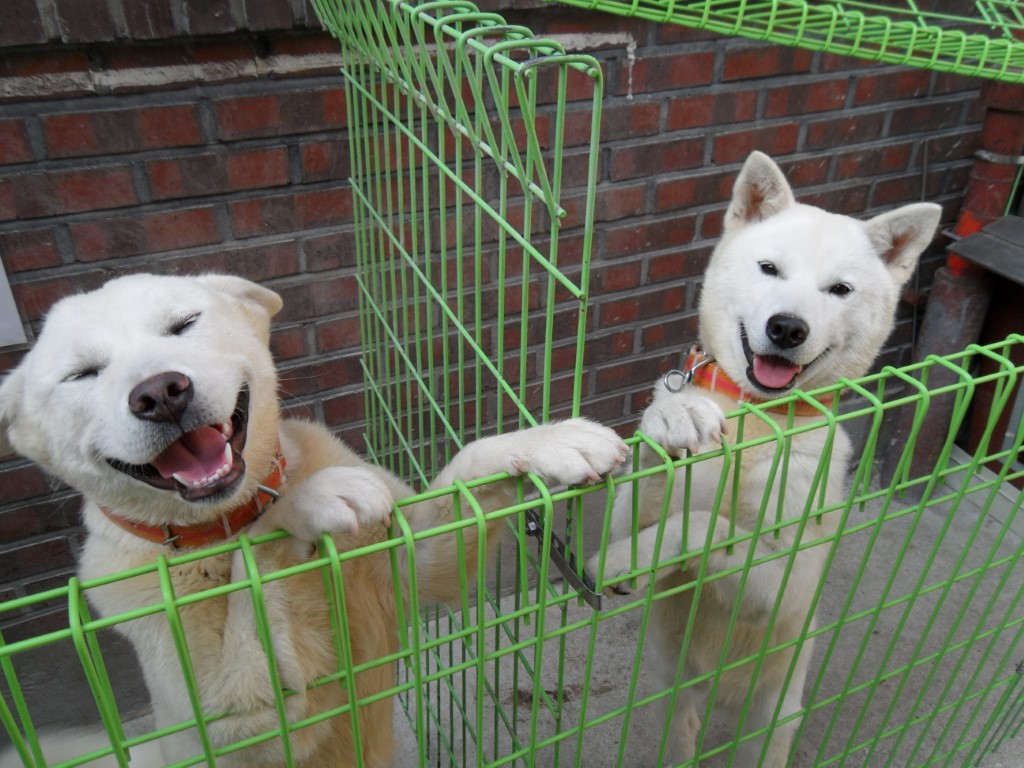 © Wikimedia.org/Maeng9981, CC BY-SA
© Wikimedia.org/Maeng9981, CC BY-SA
The Pyrenean Mastiff or Mastín del Pirineo is a Spanish breed of large livestock guardian dog from the autonomous community of Aragón in north-eastern Spain.: 552 It was traditionally used to protect flocks during the annual transhumance to high summer pasture in the Pyrenees.: 552 It is a distinct and separate breed from the Spanish Mastiff or Mastin Español and from both the Pyrenean Mountain Dog and the Pyrenean Shepherd. The Pyrenean Mastiff is a very large dog. The minimum acceptable height at the withers for dogs is 77 centimetres (30 in), and for bitches 72 centimetres (28 in); there is no upper limit, and larger dogs are preferred. They have a heavy white coat with a mask of a darker colour, and often with patches of the same colour on the body; the ears always have darker spots. The weight varies between about 60 kilograms (130 lb) and 90 kilograms (200 lb). (Source: Wikipedia.org, CC BY-SA)
The Pyrenean Mountain Dog (French: Chien de Montagne des Pyrénées) is a breed of livestock guardian dog from France, where it is commonly called the Patou. The breed comes from the French side of the Pyrenees Mountains that separate France and Spain. It is recognised as a separate breed from the closely related Pyrenean Mastiff, which is from the Spanish side of the mountains. The breed is widely used throughout France as a livestock guardian, particularly in the French Alps and Pyrenees, protecting flocks from predation by wolves and bears. The breed is known as the Great Pyrenees in the United States, where it is also used to protect flocks from various predators. (Source: Wikipedia.org, CC BY-SA)
 © Wikimedia.org/HeartSpoon, CC BY-SA
© Wikimedia.org/HeartSpoon, CC BY-SA
The Pyrenean Sheepdog, the Chien de Berger des Pyrénées in French, is a small to medium-sized breed of herding dog from the Pyrenees Mountains region of France. It is found herding flocks of sheep throughout the Pyrenees alongside the much larger Pyrenean Mountain Dog which is kept as a flock guardian. The Pyrenean Sheepdog is found in three coat types, the long-haired and goat-haired (together called the Chien de Berger des Pyrénées À Poil Long) as well as the smooth-faced (called the Chien de Berger des Pyrénées À Face Rase); the latter is recognised as a separate breed from the former two by the Société Centrale Canine. (Source: Wikipedia.org, CC BY-SA)
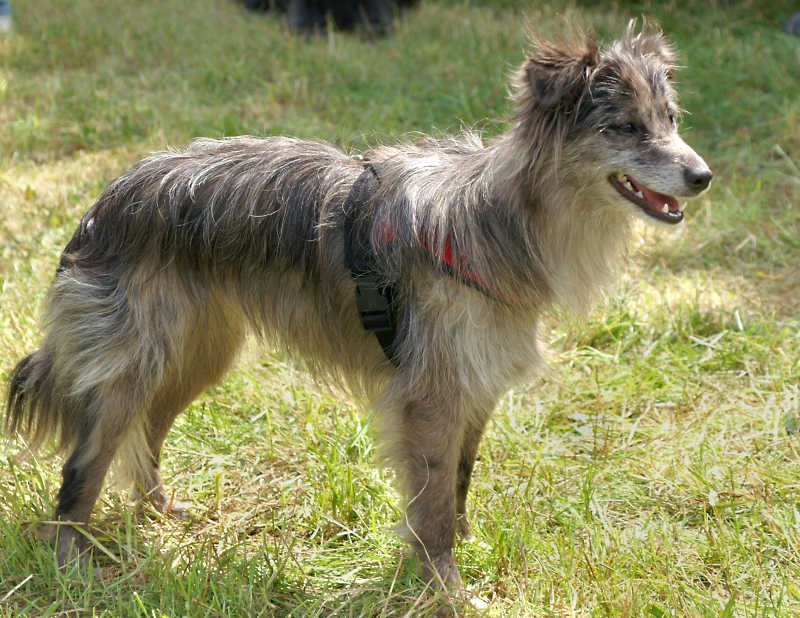 © Wikimedia.org/KeJa, CC BY-SA
© Wikimedia.org/KeJa, CC BY-SA
The Rafeiro do Alentejo is a Portuguese breed of livestock guardian dog. It is named for its area of origin, the Alentejo region of southern Portugal. It is recognised by the Clube Português de Canicultura, and was definitively accepted by the Fédération Cynologique Internationale in 1954. The Rafeiro is a large dog, slightly longer than it is tall, with a broad chest. The head is massive; the eyes are small and dark, the ears small, triangular and hanging. The coat is dense and straight, of short or medium length. It may be black, fawn, wolf grey or yellow, either brindled or not, but always with white markings; or may be white marked with these colours. It is not as thick as the coat of other pastoral dogs such as the Polish Tatra. (Source: Wikipedia.org, CC BY-SA)
The Rajapalayam, also known as the Polygar Hound, Shikkar Hound, or Indian Ghost Hound, is a southern Indian dog breed. The breed is named after Rajapalayam, a town in the Virudhunagar, Tamil Nadu. It is a large dog, usually measuring about 65–75 cm (25–30 inches) at the withers and weighs 30 – 45 kg. Mostly found in the centre of Tamil nadu, the Rajapalayam was bred to be the complete hunter and estate guardian with features that allow it to excel. Primarily used to hunt wild boar independent of the handler, the Rajapalayam is unique in two ways. First, it fulfills the functions of a bay dog as well as a catch dog; secondly the Rajapalayam can hunt by sight as well as track by scent. While hunting they can be relentless pursuers that are not intimidated by complex terrain or bodies of water. After finding their prey, the dogs take it down and bring it back to the handler. If the dog is unable to bring down its prey, it injures and corners the target till the handler can get to it. This dog can hunt alone, in pairs, in a pack, or with its owner. (Source: Wikipedia.org, CC BY-SA)
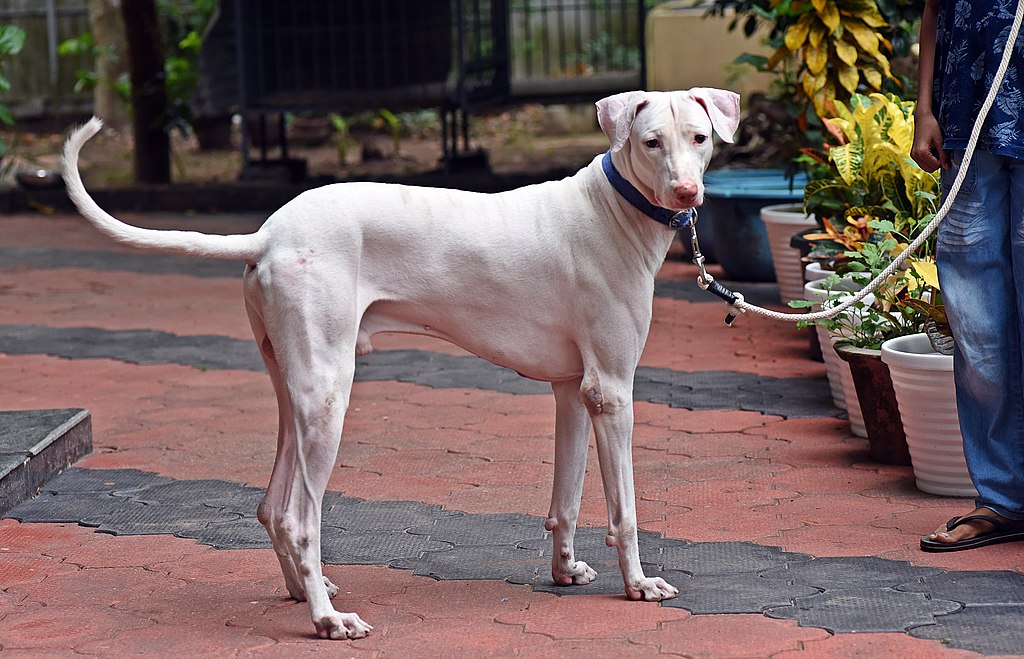 © Wikimedia.org/Pankajakshannair Manoj, CC BY-SA
© Wikimedia.org/Pankajakshannair Manoj, CC BY-SA
The Rampur Greyhound is a breed of sighthound native to the Rampur region of Northern India, which lies between Delhi and Bareilly. It is believed the Rampur Greyhound descends from early Afghan Hounds, with their present-day appearance due to extensive crosses to the Greyhound in the 19th century to improve the breed's speed. The Rampur Greyhound is a shorthaired, powerfully built sighthound that resembles the Sloughi in appearance. It is rarely seen outside of its native land where it is retained as a coursing dog and is rarely kept as a companion. (Source: Wikipedia.org, CC BY-SA)
The Rat Terrier is an American dog breed with a background as a farm dog and hunting companion. They share much ancestry with the small hunting dogs known as feists. Common throughout family farms in the 1920s and 1930s, they are now recognized by the United and American Kennel Clubs and are considered a rare breed. Rat Terrier are an intelligent and active breed that can be kept both for pest control and as a family pet. The Rat Terrier ranges from about 10 to 25 pounds (4.5 to 11.3 kg) and stands 10 to 18 inches (25 to 46 cm) at the shoulder. The miniature size – 13 inches (33 cm) and under as defined by the UKC – has become more popular as a house pet and companion dog, but the miniature is still a hunting dog. The standard says 'small to medium' and the miniature is small enough to go in and under those places where vermin like to hide. A larger strain, often in excess of 25 pounds (11 kg), has been developed. (Source: Wikipedia.org, CC BY-SA)
The Ratonero Bodeguero Andaluz (Andalusian wine-cellar rat-hunting dog) is a Spanish breed of dog of the terrier type. Its name reflects its main occupation: hunting rats and mice hidden between barrels in the wineries of Andalusia in Spain. It was recognised as an indigenous Spanish breed in 2000 by the Spanish Ministry of Agriculture and by the Spanish Kennel Club, the Real Sociedad Canina de España. The Ratonero Bodeguero Andaluz is of medium size, measuring between 13.75–16.9 inches (34.9–42.9 cm) at the withers, with an appearance very similar to that of the Jack Russell Terrier, to the extent that it has on occasion been called the Spanish Jack Russell. The breed is an agile dog with a lean and athletic build; the head is triangular with a semi-flat skull. The eyes are very dark and the Ratonero has a long muzzle, and high set ears that bend over at the tip. The tail is traditionally docked to one quarter of its length, however they may also be born with a natural bobtail. (Source: Wikipedia.org, CC BY-SA)
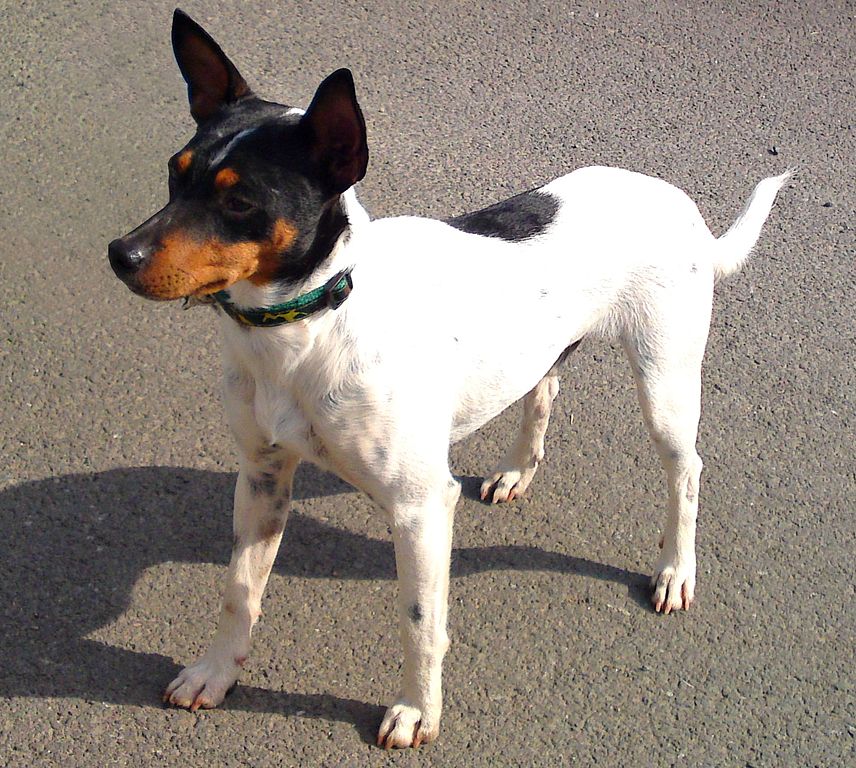 © Wikimedia.org/Monimex, CC0
© Wikimedia.org/Monimex, CC0
The Ratonero Valenciano, also known as the Gos Rater Valencià (English for: Valencian rat hunting dog), is a breed of dog that originates in Spain. Recognised by the Real Sociedad Canina de España in 2004, it has had recent success with a member of the breed winning the Spanish National Dog Show in 2011. It is a traditionally docked breed. In 2022, the FCI finally recognised the breed, naming it rather 'Terrier' than 'Ratter'. According to the breed standard, the coat should be short, no longer than 2 centimetres (0.79 in) in length. The most common markings are tricolor, with the colors dominating the white portion of the coat. Other markings include black and tan, brown and white, and brown and tan. The standard conformation show size for these dogs are 30–40 centimetres (12–16 in) for males at the withers, and 29–38 centimetres (11–15 in) for females. The ideal size is listed as 36 centimetres (14 in) and 33 centimetres (13 in) respectively. Both sexes weight ranges are the same, ideally 4–8 kilograms (8.8–17.6 lb). (Source: Wikipedia.org, CC BY-SA)
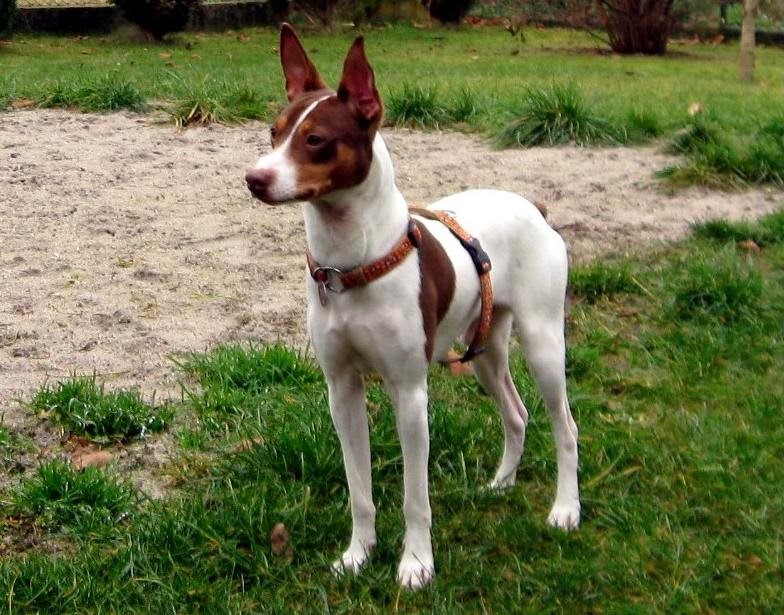 © Wikimedia.org/Monimex, CC0
© Wikimedia.org/Monimex, CC0
The Redbone Coonhound is an American breed of hunting dog. As a type of coonhound, it may be used to hunt raccoon, deer, bear, boar, cougar, or other large game. It originated in the Southern United States, and derives from foxhounds brought by immigrants from Scotland. It is characterized by its deep red coat. The Redbone Coonhound has a lean, muscular, well proportioned build. The body type is typical to the coonhounds subgroup, with long straight legs, a deep chest, and a head and tail that are held high and proud when hunting or showing. The Redbone Coonhound has brown eyes and a face that is often described as having a pleading expression. The dog's eyes may be dark brown to hazel, but a darker color is preferred. The coat is short and smooth against the body, but coarse enough to provide protection to the skin while hunting through dense underbrush. Their large paws have especially thick pads, with webbed toes, and dewclaws are common. The nose is often black and prominent, with black on the muzzle and around the eyes, called 'masking', not uncommon. The ears are floppy and will most likely extend to nearly the end of the nose if stretched out. The coat color is always a rich red, though a small amount of white on the chest, between the legs, or on the feet is sometimes seen. (Source: Wikipedia.org, CC BY-SA)
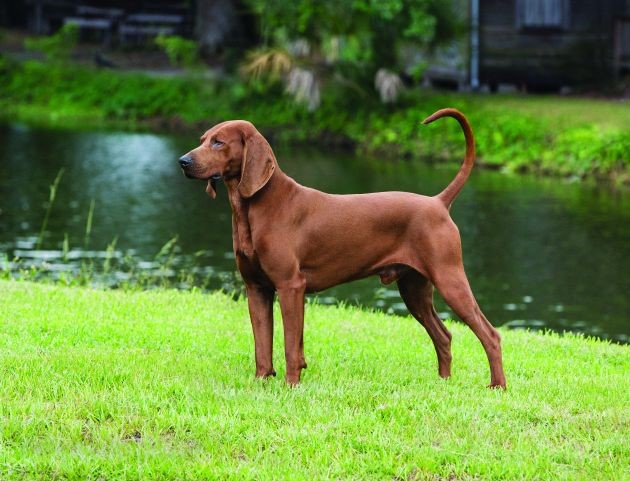 © Wikimedia.org/127177p, CC BY-SA
© Wikimedia.org/127177p, CC BY-SA
The Rhodesian Ridgeback is a large dog breed bred in the Southern Africa region. Its forebears can be traced to the semi-domesticated ridged hunting and guardian dogs of the Khoikhoi. These were interbred with European dogs by the early colonists of the Cape Colony of southern Africa. The original breed standard was drafted by F. R. Barnes, in Bulawayo, Southern Rhodesia (now Zimbabwe), in 1922, and approved by the South African Kennel Union in 1927. The Rhodesian Ridgeback at present is the only registered breed indigenous to Southern Africa. The appearance standard of the Rhodesian Ridgeback originated in Rhodesia (Zimbabwe) and goes back to the year 1922, and by 2019 this standard had remained virtually unchanged. The Rhodesian Ridgeback's distinguishing feature is the ridge of hair running along its back in the opposite direction from the rest of its coat. It consists of a fan-like area formed by two whorls of hair (called 'crowns') and tapers from immediately behind the shoulders down to the level of the hips. The ridge is usually about 2 inches (51 mm) in width at its widest point. It is believed to originate from the dog used by the original African dog population which had a similar ridge. (Source: Wikipedia.org, CC BY-SA)
The Romanian Mioritic Shepherd (Romanian: Ciobănesc Românesc Mioritic) is a large breed of livestock guardian dog that originated in the Carpathian Mountains of Romania. The male Mioritic stands about 70–75 centimetres (28–30 in) tall at the withers with the female slightly smaller at 65–70 centimetres (26–28 in). This massive dog is covered in thick fluffy hair. It may be white, with or without pale grey or cream patches, or pale grey or cream all over. The dog should have a 'vigorous' appearance. Sexual dimorphism is evident in this breed, with males being significantly larger than females. (Source: Wikipedia.org, CC BY-SA)
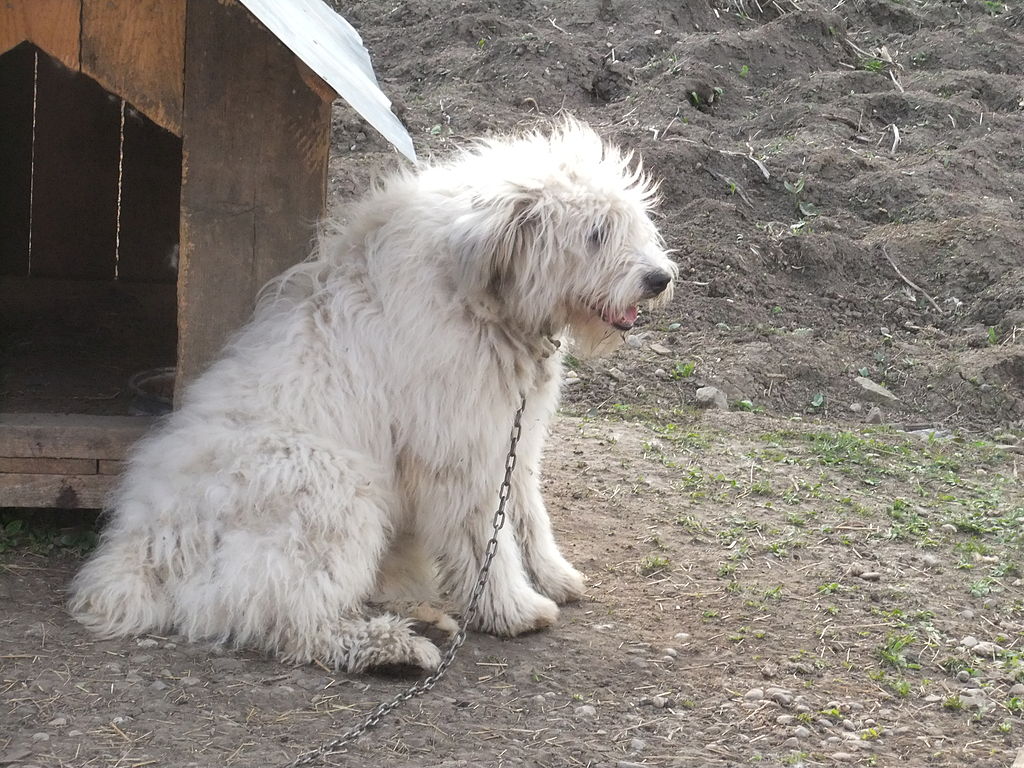 © Wikimedia.org/DorinRodina, CC BY-SA
© Wikimedia.org/DorinRodina, CC BY-SA
The Rottweiler (/ˈrɒtwaɪlər/, UK also /-vaɪlər/) is a breed of domestic dog, regarded as medium-to-large or large. The dogs were known in German as Rottweiler Metzgerhund, meaning Rottweil butchers' dogs, because their main use was to herd livestock and pull carts laden with butchered meat to market. This continued until the mid-19th century when railways replaced droving. Although still used to herd stock in many parts of the world, Rottweilers are now also used as search and rescue dogs, guard dogs, and police dogs. (Source: Wikipedia.org, CC BY-SA)
The Rough Collie (also known as the Long-Haired Collie) is a long-coated dog breed of medium to large size that, in its original form, was a type of collie used and bred for herding sheep in Scotland. More recent breeding has focused on the Collie as a show dog, and also companion. The breed specifications call for a distinctive long narrow tapered snout and tipped (semiprick) ears, so some dogs have their ears taped when young. Rough Collies generally come in shades of sable and white (sometimes mahogany), blue merle, tri-colored, and colour-headed white. (Source: Wikipedia.org, CC BY-SA)
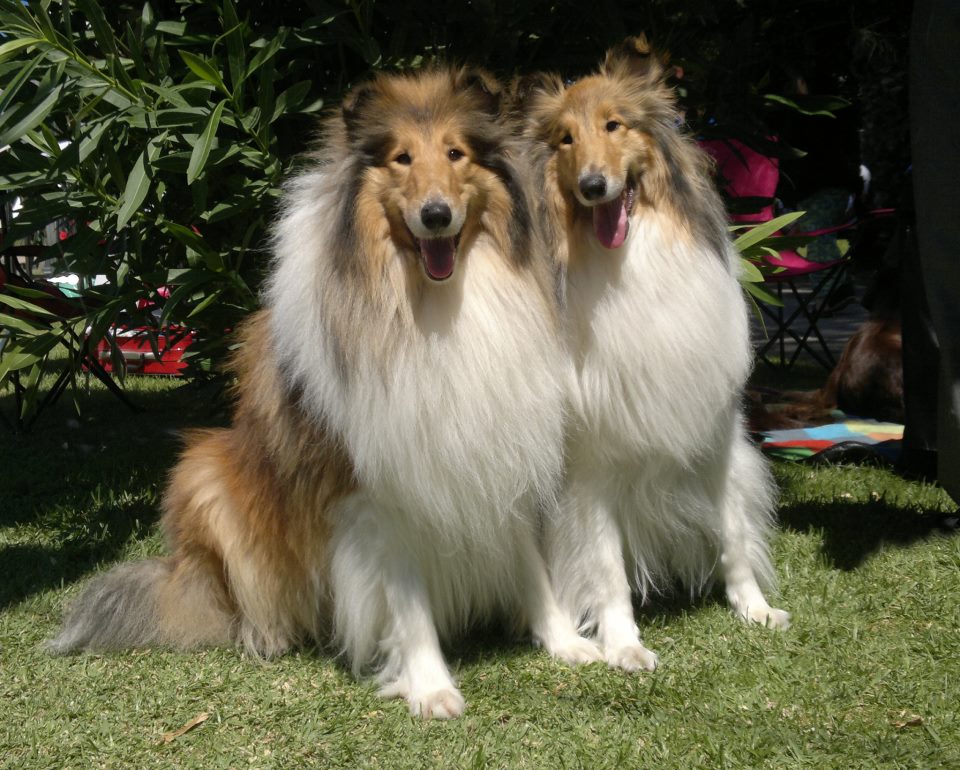 © Wikimedia.org/WisewynD, CC BY-SA
© Wikimedia.org/WisewynD, CC BY-SA
The Russian Spaniel is a type of spaniel first standardised in 1951 in the Soviet Union after World War II by cross breeding English Cocker Spaniels, English Springer Spaniels and other spaniel breeds. In 1951, the standard of the Russian spaniel was adopted, the selection of dogs for breeding began to be carried out in accordance with the requirements. Physically it is similar to a Cocker Spaniel, but has a shorter, tighter coat and a longer body. Developed and used as hunting dogs, this breed does not suffer from any major health complaints other than those normally associated with spaniels. It is the only gun dog breed originated in Russia. It is used for hunting game birds (marsh, field, upland and waterfowl birds) and hares. Popular in its native Russia, the breed was only introduced overseas in the 1990s, and is not yet recognised by any major kennel clubs, but is recognised by Russian Kynological Federation. (Source: Wikipedia.org, CC BY-SA)
The Russian Toy (also known as the Russian Toy Terrier, and in Russia as the Russkiy Toy and Toychik, Russian: Русский той, Тойчик) is a very small breed of dog originally bred in Russia from the English Toy Terrier. There are two types of coats in the breed: smooth coat and long coat. The smooth-coated variety was previously known as the Russian Toy Terrier and long-coated as the Moscow Long-Haired Toy Terrier. Both were brought together under the same Russian Toy Terrier name in 1988 and the 'Terrier' was dropped from the name when the breed was added in 2006 to the official list of breeds registered with the Fédération Cynologique Internationale and has been registered in the Foundation Stock Service of the American Kennel Club since 2008, allowed to compete in AKC companion events since 2010. The first official breed standard of the two varieties was written in 1966 in Russia. (Source: Wikipedia.org, CC BY-SA)
Russo-European Laika (Russko-Evropeĭskaya Láĭka) is the name of a breed of hunting dog that originated in the forested region of northern Europe and Russia, one of several breeds developed from landrace Laika dogs of Spitz type. The Russo-European Laika itself dates to a breeding program begun in 1944 by E. I. Shereshevsky of the All-Union Research Institute for the Hunting Industry, in Kalinin (now Tver) Province. The Russo-European Laika is described as being of medium size, males being about 54 to 60 centimetres (21 to 24 in) at the withers and females about 52 to 58 centimetres (20 to 23 in). The breed has prick ears and a sickle tail carried over the back. Temperament should be non aggressive. Colour can be any of the normal Spitz-type colours, but red and ticking on the legs is undesirable. (Source: Wikipedia.org, CC BY-SA)
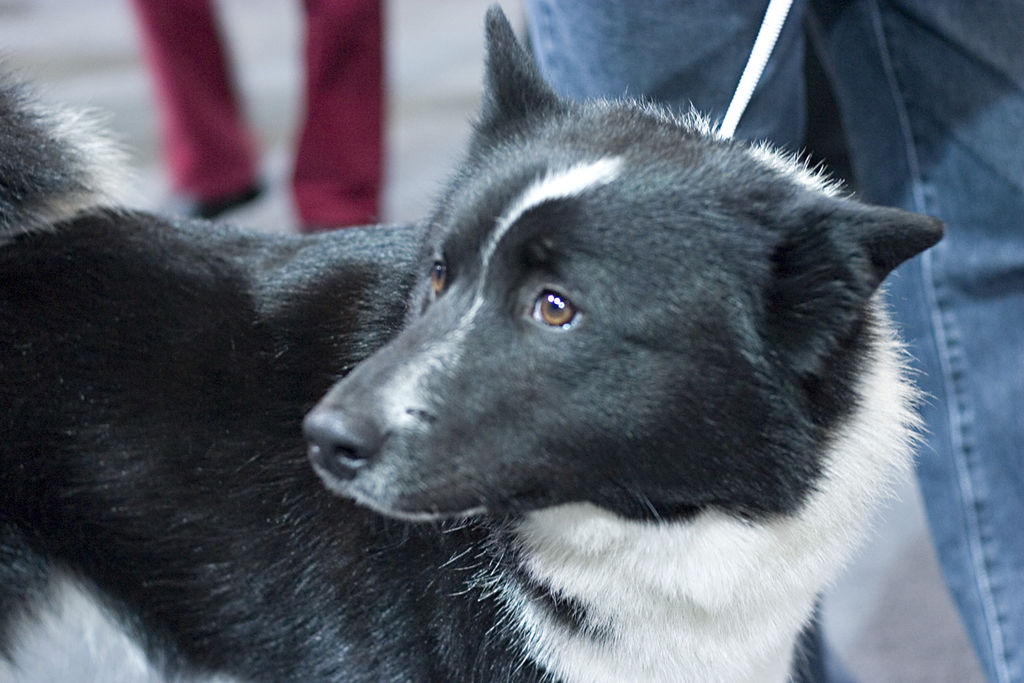 © Wikimedia.org/Konrad Loesch, CC BY
© Wikimedia.org/Konrad Loesch, CC BY

Time for recess! Post a comment, ask a question or write a review. Feel free to let us know what you think!
Most problems are a result of higher than safe driving speeds. Please just slow down and be patient.
Question 121: Poor translation: Vehicles with polluted fluids prohibited Should be translated as: Vehicles with dangerous liquids prohibited
Question 83: Poor translation: Vehicles with polluted fluids prohibited Should be translated as: Vehicles with dangerous liquids prohibited
Want even more practice? Visit similar websites offering realistic practice driving knowledge tests. Visit us to see what sets our tests apart! https://dkttest.com/capital-territory/
Cool tool! And fun to check whether I remember the rules :) Two things I noticed: Warning for a crossroad side roads on the left and right. While technically that might be the correct translation, this sign tells you, that you are on the main road and have the right of way for the next crossroad and only the next crossroad. Usually (if no sign specifies otherwise) you have to give way to drivers coming from the right at every intersection, which can get a bit annoying in communal areas, so seeing this sign feels less like a warning and more like relief :). A Fahrradstraße is not a lane for cyclists but a street for cyclists, meaning the (whole!) street is intended predominantly for cyclists, who are then allowed to ride next to each other. Cars are allowed to drive there (unless another sign prohibits such), but have to adjust their speed to the cyclists. I believe they are not allowed to pass at all, even if the oncoming lane is empty.
this website is a simpy website i love this its fat and im in my mums basement rn help sui u r a mothr fker
Hi i am such fat fan of this great gaming website. Im so hangry for the cause mate! Liking the simps eating on yall tho nott gonna lie to ya!
The system is now changed and they use some type of tablet for the exam now. Do anyone have the questions which they ask in the tablet because the questions are different. I still didn’t pass my provisional driving knowledge test. It would be great if someone could help
Good exercise !! Looking for some drift friends, hit to my email Funnyparts@gmail.com
More community